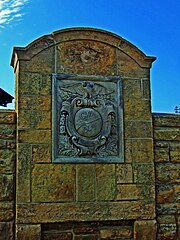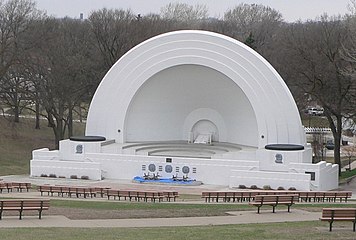Civil Works Administration: Difference between revisions
m Dating maintenance tags: {{Deadlink}} |
Tags: Reverted section blanking |
||
| Line 27: | Line 27: | ||
File:CWA Leonidas Stone School Front of building from Drone.png|alt=Front of the art work on Leonidas Stone School|[[Leonidas Stone School]] (Leonidas, Michigan). |
File:CWA Leonidas Stone School Front of building from Drone.png|alt=Front of the art work on Leonidas Stone School|[[Leonidas Stone School]] (Leonidas, Michigan). |
||
</gallery> |
</gallery> |
||
==Opposition== |
|||
Although the CWA provided much employment, there were critics who said there was nothing of permanent value. Roosevelt told his cabinet that this criticism moved him to end the program and replace it with the [[Works Progress Administration|WPA]] which would have long-term value for the society, in addition to short-term benefits for the unemployed.<ref>Harold L. Ickes, ''Secret Diary of Harold L. Ickes: The First Thousand Days 1933–1936'' (1953) p. 256 {{ISBN?}}</ref> |
|||
==See also== |
==See also== |
||
Revision as of 14:11, 13 January 2023

The Civil Works Administration (CWA) was a short-lived job creation program established by the New Deal during the Great Depression in the United States to rapidly create mostly manual-labor jobs for millions of unemployed workers. The jobs were merely temporary, for the duration of the hard winter of 1933–34. President Franklin D. Roosevelt unveiled the CWA on November 8, 1933, and put Harry L. Hopkins in charge of the short-term agency.
The CWA was a project created under the Federal Emergency Relief Administration (FERA). The CWA created construction jobs, mainly improving or constructing buildings and bridges. It ended on March 31, 1934, after spending $200 million a month and giving jobs to four million people.
Accomplishments
CWA workers laid 12 million feet of sewer pipe and built or improved 255,000 miles of roads, 40,000 schools, 3,700 playgrounds, and nearly 1,000 airports.[1] The program was praised by Alf Landon, who later ran against Roosevelt in the 1936 election.[1]
Representative of the work are one county's accomplishments in less than five months, from November 1933 to March 1934. Grand Forks County, North Dakota put 2,392 unemployed workers on its payroll at a cost of about $250,000. When the CWA began in eastern Connecticut, it could hire only 480 workers out of 1,500 who registered for jobs. Projects undertaken included work on city utility systems, public buildings, parks, and roads. Rural areas profited, with most labor being directed to roads and community schools. CWA officials gave preference to veterans with dependents, but considerable political favoritism determined which North Dakotans got jobs.[2]
-
Rock jail in Camp Verde, Arizona (1933)
-
CWA marker at Breese Stevens Field in Madison, Wisconsin (1934)
-
Marker for Grant Park in Phoenix (1934)
-
CWA project in Minnesota to straighten a road by removing a solid rock obstruction (1934)
-
CWA sanitary workers in Chicago (1933)
-
Grandview Park Music Pavilion, Sioux City, Iowa (1934)
-
Scenic boulevard built by 6,000 workers in San Francisco, California (1934)
-
El Monte Golf Course Clubhouse in Ogden, Utah (1935)
-
Hangar at the municipal airport in Montgomery, Alabama (1934)
-
Rocky Neck State Park Trail Bridge in East Lyme, Connecticut (1934)
-
Community building in Stockton, Missouri (1934)
-
Grey Eagle Village Hall in Grey Eagle, Minnesota (1934)
-
Leonidas Stone School (Leonidas, Michigan).
See also
References
- ^ a b Peters, Charles; Noah, Timothy (Jan 26, 2009), "Wrong Harry – Four million jobs in two years? FDR did it in two months", Slate
- ^ Roger D. Hardaway, "The New Deal at the Local Level: The Civil Works Administration in Grand Forks County, North Dakota," North Dakota History, 1991, Vol. 58 Issue 2, pp 20–30
Further reading
- Badger, Anthony J. "Doles and Jobs: Welfare." in The New Deal (Palgrave Macmillan, London, 1989) pp. 190–244.[ISBN missing]
- Bremer, William W. "Along the "American Way": The New Deal's Work Relief Programs for the Unemployed," Journal of American History Vol. 62, No. 3 (Dec., 1975), pp. 636–652 in JSTOR
- Hopkins, June. Harry Hopkins: Sudden hero, brash reformer (Springer, 2016).[ISBN missing]
- Lewis, Michael. "No Relief From Politics: Machine Bosses and Civil Works." Urban Affairs Quarterly 30.2 (1994): 210–226.
- Lyon, Edwin A. A new deal for southeastern archaeology (University of Alabama Press, 1996).[ISBN missing]
- Neumann, Todd C., Price V. Fishback, and Shawn Kantor. "The dynamics of relief spending and the private urban labor market during the New Deal." Journal of Economic History 70.1 (2010): 195–220. online
- Peters, Charles and Timothy Noah. "Wrong Harry – Four million jobs in two years? FDR did it in two months" Slate Jan. 26, 2009 online
- Schwartz, Bonnie Fox. The Civil Works Administration, 1933–1934: The Business of Emergency Employment in the New Deal (1984), a standard scholarly history[ISBN missing]
- Smith, Jason Scott. Building new deal liberalism: The political economy of public works, 1933–1956 (Cambridge University Press, 2006).[ISBN missing]
- Walker, Forrest A. The Civil Works Administration: an experiment in Federal work relief, 1933–1934 (1979), a standard scholarly history[ISBN missing]
Primary sources
- McJimsey, George, ed. FDR, Harry Hopkins, and the civil works administration (LexisNexis, 2006) 679 pages; vol 30. of the Documentary History of the Franklin D. Roosevelt Administration
- "Report on Civil Works Administration of Alabama, Jefferson County Division, Nov. 19, 1933 – Mar. 31, 1934" in the Birmingham Public Library's Digital Collections [dead link]
- Four million jobs in two years? FDR did it in two months.
- 1934: A New Deal for Artists" is an exhibition on the artists of the Great Depression at the Smithsonian American Art Museum
- University of Washington Libraries Digital Collections – Civil Works Administration Photographs 119 images showing work projects in King County, Washington established under the auspices of the Civil Works Administration in 1933–34.
External links
 Media related to Civil Works Administration at Wikimedia Commons
Media related to Civil Works Administration at Wikimedia Commons














